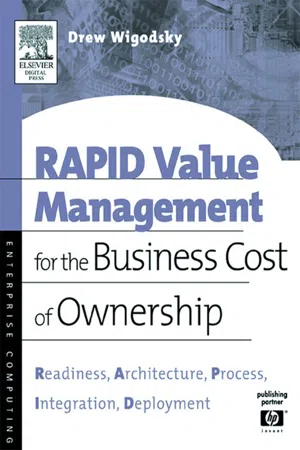
RAPID Value Management for the Business Cost of Ownership
Readiness, Architecture, Process, Integration, Deployment
- 256 pages
- English
- ePUB (mobile friendly)
- Available on iOS & Android
RAPID Value Management for the Business Cost of Ownership
Readiness, Architecture, Process, Integration, Deployment
About This Book
The model presented in this manual for the IT professional helps managers work with tech workers and their customers to make a clear and well-substantiated argument for IT service investments. In order to validate and fully explain this model, Wigodsky presents an overview of the "why" behind technology investment for any organization, and combines this with detailed real-world solutions that maximize BCO efficiency. By eliminating the "futz factor" commonly associated with system ownership costs, the book provides a glimpse of the next generation IT architecture, a repeatable process for identifying organization-wide system costs, and a customizable model for integrating BCO management with your people, processes, and technology.·Provides detailed technical architectures, processes, and integrated solutions using common computing technologies
·Helps the reader build a customized model for reviewing the long-term potential costs and benefits of interrelated IT investments
·Includes observations of HP thought leaders, experienced consultants, and customers on past projects
Frequently asked questions
Information
Taking a Razor to Information Technology (IT)
Where do you start?





Why is technology so challenging?




Table of contents
- Cover image
- Title page
- Table of Contents
- Copyright
- Dedication
- Wading Through Acronyms
- Preface
- Acknowledgements
- Chapter 1: Taking a Razor to Information Technology (IT)
- Chapter 2: On the Classification of IT Components
- Chapter 3: Using RAPID to Identify Relationship Between Architecture and Process
- Chapter 4: Readiness: Solution Strategy
- Chapter 5: Architecture: Foundation Services
- Chapter 6: Process: Best Practices
- Chapter 7: Integration: Coherent Infrastructure
- Chapter 8: Deployment: Questioning Change and Decision Making
- Chapter 9: Business Cost of Ownership
- Chapter 10: Shaping RAPID IT Solutions
- Chapter 11: RAPID IT Components
- Chapter 12: Beyond Cost of Ownership
- Hewlett-Packard ITSM Activities
- HP Infrastructure Operations
- Frequently Asked Questions
- Figures and Tables
- Index
- About the Author